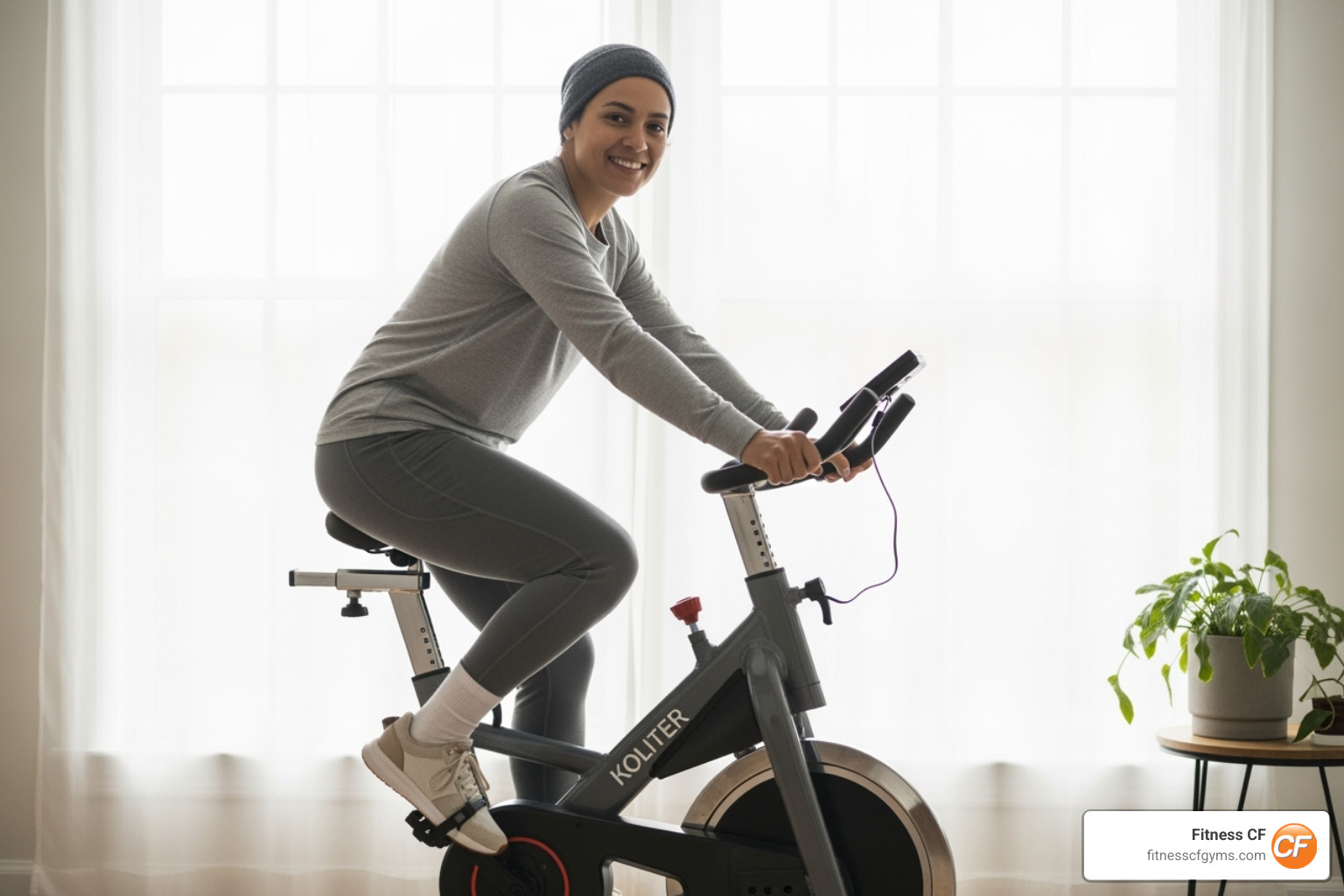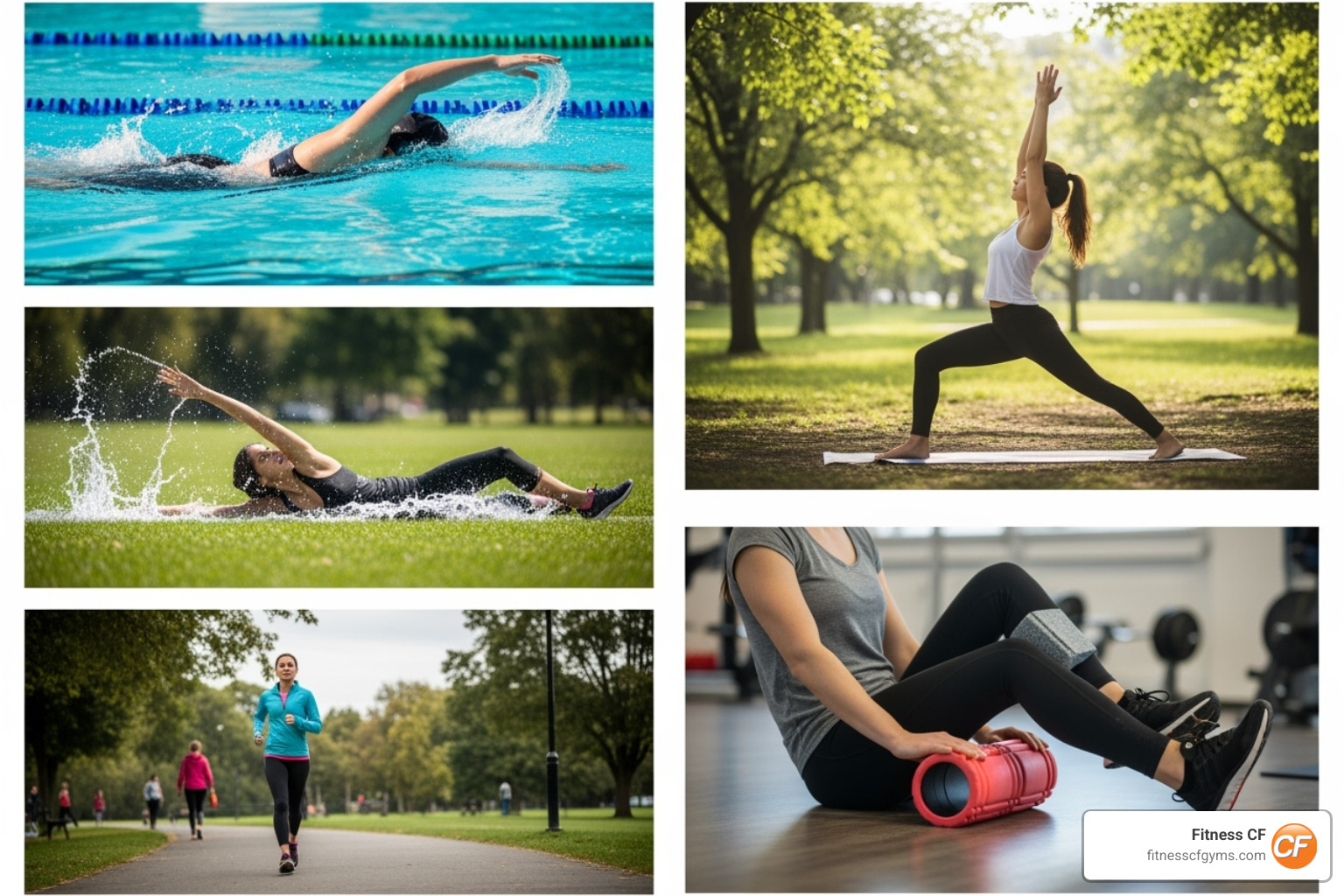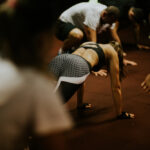Unlock Your Potential: The Power of Active Recovery for Athletes

The Power of Active Recovery for Athletes
When you push your body during workouts, recovery is just as important as the effort itself. Active recovery for athletes is a key strategy that helps your body bounce back faster and stronger. It’s not about stopping completely, but rather about smart, low-intensity movement.
Active Recovery for Athletes: Quick Facts
- What it is: Light, low-intensity exercise performed after strenuous workouts or on rest days.
- Main Goal: To help your body recover faster, reduce muscle soreness, and prepare for your next training session.
- Key Benefit: Improves blood flow, flushes out waste products, and delivers fresh nutrients to tired muscles.
After tough workouts, many athletes feel tired, sore, or hit a plateau in their progress. This is often because their muscles need help to recover. While complete rest (passive recovery) has its place, engaging in gentle activity can be more beneficial. Active recovery helps your body heal, prevents overtraining, and keeps you feeling energized for your next session.

What is Active Recovery? The Science of Smart Rest
After a tough workout, it’s natural to wonder how to bounce back efficiently. That’s where active recovery for athletes comes in. At its core, active recovery is light, low-intensity exercise performed after a strenuous workout or on a rest day. It contrasts with passive recovery, which is complete rest. While both have a place in a fitness plan, active recovery proactively helps muscles repair and restore physiological balance (homeostasis).
The main idea is to gently boost blood flow to tired muscles without adding stress. This increased circulation delivers fresh, oxygen-rich blood and vital nutrients to muscle tissues. At the same time, it helps clear metabolic byproducts that build up during intense exercise. Active recovery also supports joint health by encouraging the circulation of synovial fluid, which keeps joints lubricated, as scientific research on synovial fluid suggests.
Here’s a quick look at how active recovery stacks up against passive recovery:
| Feature | Active Recovery | Passive Recovery |
|---|---|---|
| Definition | Low-intensity movement after strenuous exercise. | Complete rest or inactivity. |
| Goal | Accelerate recovery, reduce soreness, maintain blood flow. | Allow body to fully rest, heal from injury. |
| Physiological Impact | Increases blood flow, flushes waste, delivers nutrients. | Minimal blood flow increase, complete tissue repair. |
| When to Use | General soreness, cool-down, between intense workouts. | Injury, extreme fatigue, severe pain. |
| Feeling | Invigorating, refreshed, reduces stiffness. | Complete relaxation, can lead to stiffness. |
The Physiology Behind Active Recovery
A key benefit of active recovery for athletes is managing metabolic byproducts. While once blamed on lactic acid, we now know delayed onset muscle soreness (DOMS) is more complex. Active recovery helps clear blood lactate and hydrogen ions, which contribute to muscle fatigue. Studies show that this gentle movement is effective at clearing lactate!
Soreness is primarily caused by microscopic tears in muscle fibers from intense workouts. Active recovery increases blood flow to these areas, delivering the necessary nutrients for tissue repair. It also efficiently removes cellular byproducts and helps reduce inflammation. By supporting this natural clean-up and repair process, active recovery helps your muscles bounce back faster.
Active vs. Passive Recovery: Which is Right for You?
Deciding between active and passive recovery comes down to listening to your body. For general muscle soreness or delayed onset muscle soreness (DOMS), active recovery is often your best bet. The gentle movement can loosen stiff muscles, boost circulation, and ease discomfort, preparing you for your next workout.
However, passive recovery is essential for a new injury, acute (sharp) pain, or extreme physical or mental fatigue. Pushing through with active recovery can worsen an injury or lead to burnout. It’s crucial to distinguish between normal soreness and an injury; if pain is sharp, constant, or worsening, stop and consider professional advice. True rest days are invaluable, and sometimes, doing nothing is precisely what your body needs to heal. For more tips on how to prevent and recover from common workout injuries, be sure to check out our guide.
The Key Benefits of Active Recovery for Athletes

Incorporating active recovery for athletes into your routine is a powerful, holistic strategy to boost physical performance, prevent injuries, improve mental health, and maintain consistency. When we prioritize active recovery, we’re not just bouncing back; we’re optimizing our entire athletic well-being!
Improved Physical Performance and Faster Healing
One of the most immediate benefits of active recovery is reducing delayed onset muscle soreness (DOMS). While DOMS can feel like a badge of honor, it can slow you down. Active recovery’s gentle movement helps reduce this soreness by promoting blood flow and flushing out waste products, leaving you less stiff and more ready for your next training session.
Beyond feeling better, active recovery for athletes speeds up the healing process of the tiny muscle tears from intense exercise. Increased circulation delivers oxygen-rich blood and nutrients to the areas needing repair, helping muscles rebuild and strengthen. The result is faster recovery, improved endurance, maintained strength, and better flexibility. For more ways to limber up, check out our guide on Better Flexibility: 8 Fantastic Exercises to Increase Range of Motion.
Preventing Overtraining and Boosting Mental Well-being
Pushing your limits can lead to overtraining syndrome—a state of chronic fatigue, poor sleep, muscle aches, and increased stress that affects many athletes. Watch for red flags like an unexplained performance drop, constant fatigue, or persistent aches. Active recovery is a fantastic preventative tool, allowing your body to recover without completely stopping, helping you maintain balance and avoid burnout.
The psychological benefits of active recovery for athletes are also significant. It offers a mental break from intense training and acts as a powerful stress reducer. Light, enjoyable activities like a walk in nature are proven to reduce rumination (repetitive negative thinking). This mental reset can improve sleep quality and foster a more positive mindset about your fitness journey. Understanding this connection between physical activity and mental wellness is key to long-term success. Find more about this powerful link in our article, Embracing Winter Wellness: The Powerful Connection Between Fitness and Mental Health.
How to Implement Active Recovery: Timing, Intensity, and Activities
Now that we understand the ‘why,’ let’s dive into the ‘how.’ Successfully integrating active recovery for athletes into your routine requires smart planning regarding timing, intensity, and the types of activities you choose. It’s all about making recovery a seamless part of your overall training strategy.
When to Schedule Your Active Recovery for Athletes
Active recovery isn’t just for rest days; it can be strategically woven into your workout structure:
- During Workouts (Between High-Intensity Sets): Use low-intensity movement like a light jog or walk between intense sets instead of stopping completely. This helps clear metabolic waste and keeps blood flowing, preparing you for the next burst of effort. A study by the American Council on Exercise found that athletes recovered faster continuing at 50 percent of their maximum effort between intervals compared to stopping completely.
- Post-Workout Cool-Down: The immediate minutes after a strenuous session are ideal for active recovery. A 6-10 minute cool-down, such as a gentle walk or bike ride, helps gradually bring your heart rate down, reduce muscle stiffness, and initiate recovery. Cooling down helps control blood flow and prevent blood pooling, which can cause dizziness. For more on effective cool-downs, see The Importance of Warm-Up and Cool-Down Exercises: A Comprehensive Guide.
- Dedicated Rest Days: This is perhaps the most common application. On days you’re not doing intense training, opt for low-impact activities that promote blood flow and mobility without adding significant stress. This keeps your body moving and reduces stiffness.
Finding the Right Intensity and Duration
The key to effective active recovery is low intensity to support recovery, not create more fatigue. The general guideline is to keep your heart rate between 30-60% of your maximum heart rate. This is often described as working at an effort level where you can easily carry on a conversation—the “talk-test.” If you’re huffing and puffing, you’re working too hard.
As for duration, it depends on when you’re implementing it:
- Cool-downs: Active recovery interventions lasting 6-10 minutes revealed consistently positive effects on performance.
- Between intense training days: Aim for 20-45 minutes. This allows enough time for sustained blood flow benefits without overtaxing your system.
- Overall: The goal is to finish your active recovery session feeling invigorated, not exhausted. If you feel drained afterward, it was too intense or too long.
LIST of Effective Active Recovery Exercises

Here are some of our favorite effective examples of active recovery for athletes:
- Walking: The simplest and most accessible form. A brisk walk outdoors or on a treadmill is excellent for promoting circulation.
- Light Jogging: For seasoned runners, a very slow, easy jog can be active recovery, but for others, it might be too intense. Remember the talk-test!
- Cycling: Whether on a stationary bike or outdoors, cycling at a low, conversational pace is a fantastic, low-impact option.
- Swimming: The buoyancy of water makes swimming incredibly gentle on the joints. It’s excellent for full-body circulation and can be very relaxing. Studies show water-based exercise can improve quality of life, sleep, and flexibility.
- Water Aerobics: Similar to swimming, water aerobics offers resistance without high impact, making it ideal for joint-friendly movement.
- Gentle Yoga: Focus on restorative poses, gentle flows, and deep breathing. Yoga improves flexibility, range of motion, and promotes relaxation. Explore the Power of Yoga: Why You Should Add It to Your Fitness Routine.
- Dynamic Stretching: Unlike static stretching (holding a stretch), dynamic stretching involves continuous movement through a range of motion.
- Mobility Work: Gentle movements that focus on improving joint range of motion and overall body control, often without external load.
- Foam Rolling: Self-myofascial release with a foam roller is a fantastic active recovery tool. It helps reduce muscle tightness, increase blood flow, and alleviate soreness. Studies show it can reduce delayed-onset muscle soreness after high-intensity interval training (HIIT).
Creating Your Weekly Active Recovery Plan
Crafting a smart weekly training schedule means embracing active recovery for athletes as a core part of your plan. This approach, often called periodization, involves carefully varying training intensity and volume to ensure your body gets the right amount of recovery and adaptation, helping you build strength and endurance without burnout. Planning your active recovery is a powerful investment in your performance.
Who Benefits Most from Active Recovery for Athletes?
Active recovery is beneficial for almost everyone who is physically active:
- Endurance Athletes like runners and cyclists find it invaluable for maintaining blood flow, flushing byproducts, and preventing stiffness.
- Strength Athletes, including weightlifters, benefit from increased circulation, which aids muscle repair and reduces soreness.
- Team Sport Players in sports like soccer or basketball can use it to bounce back faster from explosive movements and maintain agility.
- Weekend Warriors can combat intense soreness after strenuous weekend sessions. Studies show this activity pattern can even reduce the risk of death from heart disease.
- Fitness Enthusiasts & Beginners will find it helps manage initial muscle soreness and builds a sustainable routine.
- Elite Competitors benefit physically and mentally, helping them stay sharp and resilient during grueling training cycles.
Sample Weekly Schedules
Here’s how you might weave active recovery for athletes into different training weeks to balance hard work with smart recovery.

For a strength training focus (3-4x/week), alternate intense lifting with active recovery. For example: Mon (Upper Body), Tue (Active Recovery: 30-min walk/yoga), Wed (Lower Body), Thu (Active Recovery: 20-min cycle/foam rolling), Fri (Full Body/Core), Sat (Active Recovery: swim/hike), Sun (Passive Rest).
For an endurance training focus (5-6x/week): Mon (High-Intensity Run/Bike), Tue (Active Recovery: swim/stretch), Wed (Moderate Run/Bike), Thu (Active Recovery: light cross-training), Fri (Long, Slow Distance), Sat (Active Recovery: yoga/walk), Sun (Passive Rest).
The key is balancing intensity with recovery. Research suggests an 80/20 split (80% low-to-moderate intensity, 20% high-intensity) for optimal adaptations. This principle applies to active recovery to avoid overdoing it. Always alternate muscle groups, allowing 24-48 hours of rest before working them again.
When to Choose Passive Recovery Instead
While active recovery for athletes is powerful, passive recovery (doing nothing) is sometimes necessary. It’s crucial to distinguish soreness from injury. If you have immediate, acute, or sharp pain that persists, it’s likely an injury. Avoid active recovery, opt for passive rest (like the RICE method), and seek professional medical advice. For a detailed breakdown, it’s helpful to know how to tell the difference between soreness and an injury.
Furthermore, choose passive rest when battling extreme physical or mental fatigue, or if you’re feeling ill. Pushing your body when it’s depleted can prolong recovery. The American Council on Exercise (ACE) suggests high-intensity exercisers schedule a full rest day every seven to ten days. These true rest days are vital for nervous system recovery, hormone regulation, and mental rejuvenation. You might be missing out on these 7 Key Benefits of Rest Days!
Frequently Asked Questions about Active Recovery
It’s natural to have questions about how to best support your body. Let’s clear up some common curiosities about active recovery for athletes.
Can active recovery replace a full rest day?
While active recovery for athletes is beneficial, it doesn’t replace full, passive rest days. Active recovery helps with immediate muscle repair, but passive rest is crucial for nervous system recovery, hormone rebalancing, and mental breaks. If you’re exhausted or nearing overtraining, a complete rest day is best. The smartest approach is a blend of both, listening to your body’s signals.
Does nutrition play a role in active recovery?
Absolutely. Nutrition is a pillar of any effective recovery plan. You must fuel your body to recover and rebuild. Proper hydration is key for transporting nutrients and removing waste. Protein is essential for rebuilding muscle, and carbohydrates are crucial for replenishing glycogen stores burned during exercise. Active recovery improves the delivery of these nutrients to your muscles, maximizing their repair. For more specific guidance on fueling your body right, be sure to check out our guide on What to Eat After a Workout.
Is foam rolling considered active recovery?
Yes, self-myofascial release (SMR) with a foam roller is a valuable form of active recovery. While not a cardio activity, it actively works on muscles by increasing blood flow, releasing tightness, and breaking up knots. This reduces soreness and improves flexibility, contributing to overall recovery. It’s a fantastic tool for cool-downs or active recovery days to target tight spots. Curious about other ways to soothe those sore muscles? Learn more in What Are the Best Ways to Relieve Sore Muscles?.
Conclusion: Make Recovery an Active Part of Your Success
We’ve journeyed through active recovery for athletes, and it’s clear this isn’t just a trend. It’s a powerful, proactive strategy that can transform your training, speed up your healing, and open up your full athletic potential. By embracing smart, low-intensity movement, you’re not just recovering; you’re building a stronger, more resilient you.
Active recovery is a scientifically proven path to bouncing back faster, performing at your best, and keeping injuries at bay. Whether you weave gentle movement into your workouts, use it as a cool-down, or make it a key part of your rest days, you’re actively supporting your body’s ability to adapt and grow stronger.
The most important part of any recovery plan is listening to your body. Choose activities you genuinely enjoy, and always balance your active recovery with essential moments of complete, passive rest. Both play a vital role in your overall well-being and progress.
At Fitness CF, we’re all about empowering you on your fitness journey. We believe in giving you the knowledge and resources to reach your goals safely and effectively. That’s why our gyms offer a wide range of amenities. From high-energy fitness classes and invigorating spin sessions to calming yoga and personalized personal training, we have options designed to support every aspect of your wellness journey – from intense workouts to smart recovery.
Ready to make recovery an active part of your success story? We invite you to explore our fitness programs and start your journey to a healthier lifestyle with us today!





